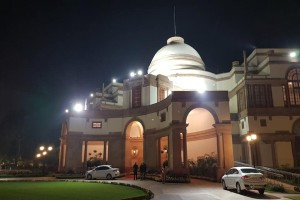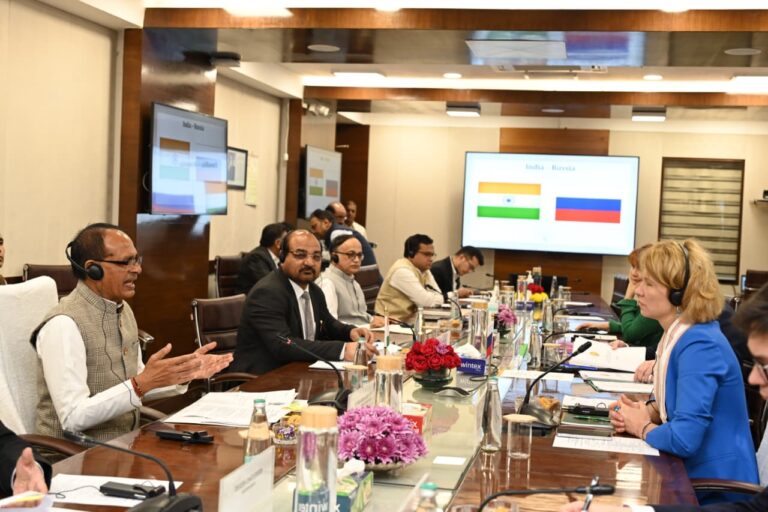
Hyderabad House, New Delhi
Hyderabad House, New Delhi. Photo by Ambassador Manish Prabhat
Book Review
Princely Palaces in New Delhi

Author: Sumanta K Bhowmick
Publisher: Niyogi Books, Delhi
264pp, 140 photographs
ISBN: 978-93-83098-91-0

The pages of history are replete with many wonders. Some get highlighted more than others while some remain hidden behind the curtains. Some of them you find before your eyes but they do not get the attention they deserve.
If you are a resident in Delhi or a visitor to the capital, one of the must-go places is India Gate. Once at India Gate, you may marvel at the memorial to the departed soldiers or enjoy an ice-cream from the local cart. You cannot ignore the ‘palaces’ around India Gate – with huge domes, chhatris and chajja – a blend of Western architecture and Indian motifs. Each of them is identified with a princely state that speaks of history long lost – Hyderabad House, Patiala House, Jaipur House, Dholpur House, Mandi House and so on. Ever thought for what purpose they could have been built originally and by whom?
British Indian Empire was divided into two parts – British India and Princely India, writes Sumanta K Bhowmick in his book ‘Princely Palaces in New Delhi’ (Niyogi Books, 2016) that delineates the story of these palaces around C-hexagon and on the roads emanating from the hexagon. Princely India, covering one-third the area of British Indian Empire, had a significant political presence during British rule in India. At the Delhi Durbar attended for the first time by King-Emperor George V and his Queen in 1911, an announcement was made to shift the capital from Calcutta (now Kolkata) to Delhi. Just as the project started rolling, the 500-odd princely states were invited to build palaces in the ‘new’ imperial capital.
Why did the government invite the princely states to acquire such prime land? What advantages did the government foresee to invite the princes? How was the area fixed for each palace and what was the price paid by the princely states? Who were the people that inhabited these ‘small’ palaces? Those were the times when Britain was entangled in World War II that not only sucked the lives of the soldiers but emptied the coffer too. The princes of India donated generously for the war purposes while some participated in it. How did they manage to use funds at this critical juncture to build palaces in ‘new’ Delhi? Above all, what was the social history of those times when the princes were eager to pay a visit to the Viceroy and to welcome him in turn to their palaces? Bhowmick, who came to Delhi from Bhagalpur in Bihar, often wondered about these palaces and tried to find answers to numerous questions. If you want to peek into this world of princely glamour, pomp, tradition, etiquette, along with details of architecture and architect, there is no other better testament than Bhowmick’s thoroughly researched book.
The book, hardback and tastefully designed, is replete with archival documents and rare, unpublished photographs collected from royal archives. It invites the readers to the Delhi of yore that was never short of interesting anecdotes and facts. We get to know that Hitler’s gift of a priceless Maybach car to the Maharaja of Patiala was handed over free of cost to someone who asked for it; the Nizam of Hyderabad, famously known as a penny-pincher, threw a lavish garden party at his Delhi palace in 1954 attended by the President, Prime Minister and Eleanor Roosevelt; the seeds of Asian Games germinated in a meeting of 13 nations under the leadership of the Maharaja of Patiala in Patiala House; while the princely state of Jaipur contributed a large chunk of land for the making of New Delhi, Jaipur House, the piece of land on which it stands today, was originally slated to be the Princes’ Club! This and many other hidden facets of the history of New Delhi can be found within the covers of Bhowmick’s wonderful book.
Bhowmick has based his research on primary sources, stored in the State archives and private archives. He also made it a point to contact the erstwhile royal families to share their memories of respective Delhi palaces. Some of these were designed by Sir Edwin Lutyens, the city’s chief architect, and the rest by other British architects. The architecture was neo-classical and Art Deco but native architectural style was not insisted upon by the Maharajas. These princely palaces are now being used for various purposes, ranging from meeting place, art gallery, cultural centre, and government offices and so on. Whatever be the use of these historic ‘houses’, they represent the architectural heritage of New Delhi. It is nice to see that these are being maintained by the government through recent renovations and conservation projects. So, before you plan to visit India gate again, get prepared with more knowledge about the palaces around you.
– global bihari bureau





